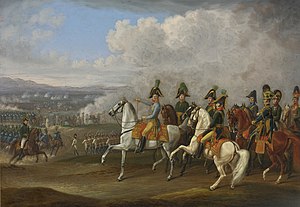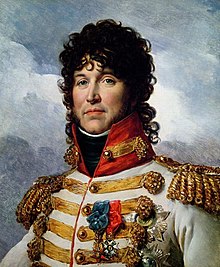| Italian Campaign of 1813-1814 | |||||||||
|---|---|---|---|---|---|---|---|---|---|
 General von Bellegarde and his staff in a painting by Albrecht Adam of 1815 | |||||||||
| |||||||||
| Belligerents | |||||||||
|
|
| ||||||||
| Commanders and leaders | |||||||||
|
|
| ||||||||
| Strength | |||||||||
|
50,000 Austrian soldiers (1813) 30,000 Neapolitan soldiers (since 1814) |
100,000 soldiers in total (summer 1813) 46,000 Franco-Italian soldiers (since 1814) | ||||||||
| Casualties and losses | |||||||||
| Thousands of dead, wounded and captured | Thousands of dead, wounded and captured | ||||||||
The Italian Campaign of 1813-1814 was the series of military operations fought during the War of the Sixth Coalition, mainly in northern Italy between the French Empire and the Coalition led by Austrians and British. It represented the last time of the so-called "French period", precisely from the campaign of 1796-1797, in which a French and an Austrian army confronted each other for control of the Italian peninsula. The Austro-Neapolitan War of 1815 was essentially a clash between only Italians and Austrians.

After the disastrous Russian campaign, the Army of the Kingdom of Italy was severely weakened. It distinguished itself once again during the German campaign of 1813, but when the Austrian Empire entered the war on 12 August, it was largely recalled south to face the Coalition invasion. The Franco-Italian army was commanded by the viceroy of Italy Eugène de Beauharnais, stepson of Napoleon Bonaparte, while the allied army, in this theatre of operations, was placed under the command of the Austrian field marshal Heinrich Johann Bellegarde and the British general William Bentinck. Alongside the Austrians and the British there were again the Kingdom of Sicily of Ferdinand IV of Bourbon and the Kingdom of Sardinia of Victor Emmanuel I.

Initially the Franco-Italians managed to slow down the advance of the Coalition in the Illyrian Provinces, thanks above all to the Battle of Feistritz, but already on 5 October they had to fall back towards the Isonzo, the eastern border of the Kingdom of Italy, and in the middle of month began the invasion of the kingdom. The already disproportion of forces was aggravated by the defection of the Kingdom of Bavaria of Maximilian I Joseph of Bavaria[3] first and, above all, of the Kingdom of Naples[4] [5][6] of Joachim Murat thereafter. Murat had chosen to change sides not only to maintain his dominion, but also to expand it, trying in this way to carry out his project to unify much of Italy under his person.

However, the troops of Beauharnais continued to fight valiantly in the Po Valley and obtained tactical victories against the Austrians in the battles of Caldiero and Mincio; however, the spring of 1814 was marked by the defeats in the battles of San Maurizio and the Taro and by the progressive advance of the Coalition in the Italian territory. Meanwhile, Napoleon was defeated in the Campaign in north-east France (1814) and consequently abdicated as Emperor of the French and King of Italy in April. From that moment the Napoleonic authority in the peninsula actually ceased to exist. On April 23, Eugène de Beauharnais was forced to sign the Convention of Mantua, and then self-exiled to Bavaria. By the end of the month the remaining Italian garrisons had to surrender.
The fall of the Kingdom of Italy was a particularly traumatic event for Italian patriots and intellectuals, including Ugo Foscolo, Giovanni Berchet and Alessandro Manzoni, who saw the dream of a united Italy shattered. Manzoni in particular wrote a song entitled " April 1814 " in which he wished to maintain the independence of the kingdom, which was not done at the behest of the Congress of Vienna.[7][8] The memory of a free and liberal Italian state under Napoleon will give the necessary impetus to the patriots[9] during the Risorgimento, to continue fighting for unification.
- ^ Only de jure, in fact, the Kingdom of Naples did not participate in military operations alongside the French Empire, because King Joachim Murat was negotiating with the Coalition to change sides.
- ^ De facto only Murat, as the Army of the Kingdom of Naples never really fought against the Coalition during the campaign, and was only mobilized against the army of Beauharnais.
- ^ Barton, Pp.94–95.
- ^ Delpu, Pierre-Marie (2016). "Les répercussions de la campagne de Russie dans le royaume de Naples (1812-1815) : origine ou révélateur d'une crise politique ?". Annales historiques de la Révolution française. 384 (2 384).
- ^ Costa 2019, p. 260.
- ^ Ferrero 1999, p. 236.
- ^ Langella , p. 70 , Tellini , p. 84 and Manzoni writer and European reader
- ^ Tellini , p. 84
- ^ Many of them veterans of the Napoleonic Italian armies themselves
© MMXXIII Rich X Search. We shall prevail. All rights reserved. Rich X Search
